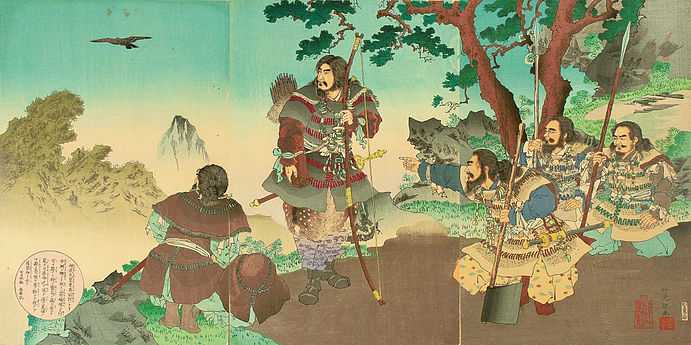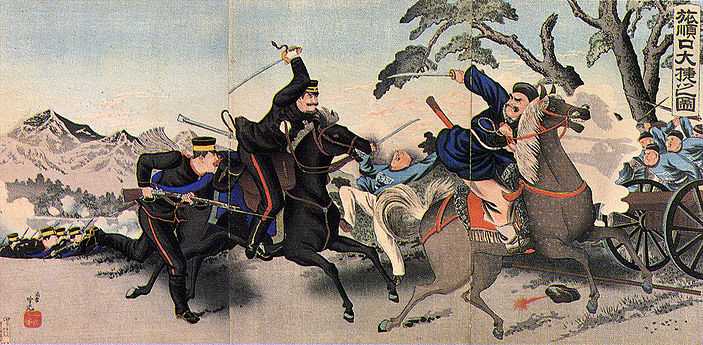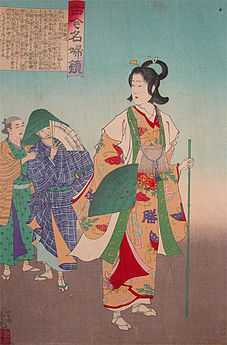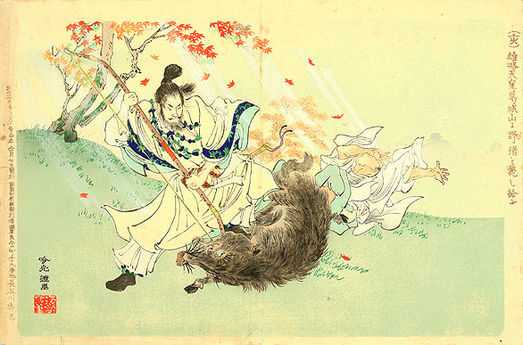Adachi Ginkō

Adachi Ginkō (安達 吟光, active c. 1873 – 1908) was a Japanese artist best known for his prints in the ukiyo-e style as a member of the Utagawa school. He worked in a variety of genres, including portraits of beauties and actors, landscapes, book illustrations, and satirical works, and produced a large number of triptychs of contemporary events. His most successful work was his Pictorial Outline of Japanese History series of triptychs in the late 1880s. He was jailed and fined in 1889 for caricaturing Emperor Meiji. Ginkō also worked under the art names Shōsetsusai, Shinshō, and Shōsai.[1]
Life and career
The details of Adachi Heisichi's (安達 平七, art name Ginkō) birth and early life are unknown. He studied under the painter Goseda Hōryū , who worked in a Western style. Ginkō may have begun designing ukiyo-e woodblock prints as early as 1870, though these purported prints of the Boshin War have not survived. Ginkō's earliest surviving prints date to 1873—a number of yakusha-e prints of actors in the style of Toyohara Kunichika. He found success with a series of actor prints in 1874 titled Complete Issue of Top Battle Stories (講談一席読切 Kōdan isseki yomikiri).[1]
Ginkō produced in a variety of genres, including bijin-ga portraits of beauties, landscapes, book illustrations, and satirical works. A large number of his works dealt with contemporary events such as the Satsuma Rebellion and the First Sino-Japanese War. His most popular work was the series of triptychs Pictorial Outline of Japanese History (大日本帝国議会之図 Dainippon shiryaku zue), published from 1185 to 1889.[1]
The 28 February 1889[2] issue of Journal of the Society of Ready Wit (頓智協会雑誌 Tonchi Kyōkai Zasshi) published a cartoon by Ginkō which parodies a print of his own of Emperor Meiji receiving the Meiji Constitution of 1889, called View of the Issuance of the State Constitution in the State Chamber of the New Imperial Palace (新皇居於テ正殿憲法発布式之図 Shin kōkyo ni oite seiden kenpō happushiki no zu).[1] The latter, full-colour triptych was produced on commission, and was not distributed until 14 March 1889; prints had to get censor approval before distribution, while books and magazines did not have to be sent to the censors until after they began distribution.[3] The parody replaces the Emperor with a skeleton and is captioned: "Promulgation Ceremony for the Sharpening of the Ready Wit Law" (頓智研法発布式之図 "Tonchi kenpō happushiki no zu").[1] The skeleton was a play on words of the name of magazine's publisher Miyatake Gaikotsu, whose given name is a homophone of the Japanese word gaikotsu ("skeleton").[4]
- Meiji Constitution controversy
-
_View_of_the_Issuance_of_the_State_Constitution_in_the_State_Chamber_of_the_New_Imperial_Palace_(cropped_and_rotated).jpg)
View of the Issuance of the State Constitution in the State Chamber of the New Imperial Palace, 1889
-
_Tonchi_kenp%C5%8D_happushiki_no_zu.jpg)
"Promulgation Ceremony for the Sharpening of the Ready Wit Law", 1889
Ginkō was imprisoned for a year[4] and fined 50 yen for the offense.[1] Miyatake was imprisoned for three years,[4] all others involved were also given prison time, and the magazine was made to cease publication. Following his release, Ginkō continued to produce prints, the last known of which appeared in 1908. His date and place of death are unknown.[1] Ginkō also worked under the art names Shōsetsusai Ginkō (松雪斎 銀光, c. 1873–75), Shinshō Ginkō (真匠 銀光, c. 1877), and Shōsai Ginkō (松斎 吟光, c. 1881–89),[1] and was a member of the Utagawa school.[5]
Galleries
- Triptychs by Adachi Ginkō
-

Emperor Jinmu, 1891, from Stories from Nihonki
-

Severe Battle at Haicheng, 1894
-
_-_Google_Art_Project.jpg)
The Great Battle at Lushunkou, 1894
-

Great Victory at Port Arthur, 1894
- Other prints by Adachi Ginkō
-

The Prostitute Katsuyama
-

Emperor Yūryaku and a Boar, 1896
References
- ↑ 1.0 1.1 1.2 1.3 1.4 1.5 1.6 1.7 Marks 2012, p. 174.
- ↑ Fujitani 1996, p. 199.
- ↑ Meech 1986, p. 184.
- ↑ 4.0 4.1 4.2 Fujitani 1996, p. 198.
- ↑ Conant 2006, p. 94.
Works cited
- Conant, Ellen P. (2006). Challenging Past And Present: The Metamorphosis of Nineteenth-Century Japanese Art. University of Hawaii Press. ISBN 978-0-8248-2937-7.
- Fujitani, Takashi (1996). Splendid Monarchy: Power and Pageantry in Modern Japan. University of California Press. ISBN 978-0-520-20237-5.
- Marks, Andreas (2012). Japanese Woodblock Prints: Artists, Publishers and Masterworks: 1680–1900. Tuttle Publishing. ISBN 978-1-4629-0599-7.
- Meech, Julia (1986). The World of the Meiji Print: Impressions of a New Civilization. Weatherhill. ISBN 978-0-8348-0209-4.
External links
-
 Media related to Adachi Ginkō at Wikimedia Commons
Media related to Adachi Ginkō at Wikimedia Commons - Adachi Ginkō prints at ukiyo-e.org
|